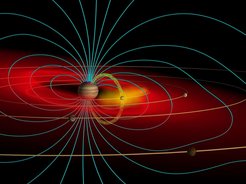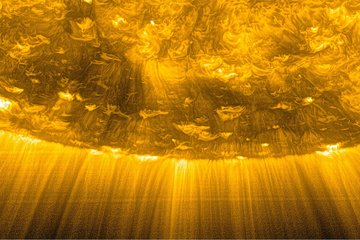Planetary plasma environment
Jupiter’s magnetosphere and the space plasma environment of the Galilean moons
The European Space Agency (ESA) launched the Jupiter Icy Moons Explorer (JUICE), its first mission to explore the jovian system on 14 April 2023. JUICE aims to characterize the conditions that may have led to the emergence of habitable environments among the Jovian icy satellites. Its primary target will be Ganymede, the solar system’s largest moon and the only one known to generate its own magnetic field. Ganymede is believed to contain an ocean of liquid water below its icy surface, making it a prime target for astrobiological investigations. JUICE will orbit Ganymede in the final year of its mission (the first one to attempt this at a planetary moon other than Earth’s), allowing us to study its surface, atmosphere, subsurface and mini-magnetosphere in unprecedented detail. Two more jovian moons that are believed to host subsurface oceans (Europa and Callisto) will also be explored in-situ by JUICE with numerous targeted flybys before the Ganymede orbit phase. During that period, JUICE will also perform an extensive survey of Jupiter’s magnetosphere, the environment within which the aforementioned moons orbit, as well as study the planet, its atmosphere, rings and neutral tori. JUICE will achieve its goals through observations by 11 science instruments that will characterize the interplay of the different physical processes that take place among the various components of the complex jovian system and impact the way we understand its moons and their potential oceans.
The Planetary Plasma Environments group (PPE) has a strong heritage in the exploration of planetary magnetospheres and space plasma interactions throughout the solar system. It has contributed instruments to several past missions that flew-by or orbited Jupiter (Galileo, Cassini, Ulysses). The PPE participates in the JUICE mission by contributing hardware and scientific expertise to the Particle Environment Package (PEP). PEP actually comprises six different detector elements that aim to map the neutral and charged particle environment of Jupiter’s magnetosphere and moons (ions, electrons, exospheric neutral gas, thermal plasma and energetic neutral atoms) between energies of 1 meV and several MeV. One of these elements, the Jovian Electron Ion (JEI) sensor, has been designed and built by MPS/PPE. PEP/JEI will measure electrons and ions between few eV up to about 50 keV. PEP measurements will be critical for a variety of investigations, ranging from planetary physics (e.g. determination of subsurface ocean properties, surface-plasma interactions), to fundamental space plasma physics (e.g. magnetospheric science, radiation belts).
In preparation for the highly anticipated scientific investigations of JUICE/PEP and given the increased interest for the investigation of Jupiter’s magnetosphere, the PPE offers a PhD thesis project with the following possible topics:
- The plasma & energetic charged particle environment of Jupiter’s galilean moons: average state and dynamics
- The surface charging of Ganymede: simulations and expected observations by PEP/JEI
- Comparative radiation belts(Jupiter vs. Saturn vs. Earth)
- The high-energy calibration of PEP/JEI: laboratory measurements and simulations
PPE is a data-intensive group, so any project offered would primarily data-analysis based. A possibility to complement data analysis with simulations is also welcome. For the PhD thesis offered, available data sources may involve measurements by Galileo, Ulysses, Cassini, Juno and HISAKI.













